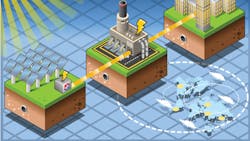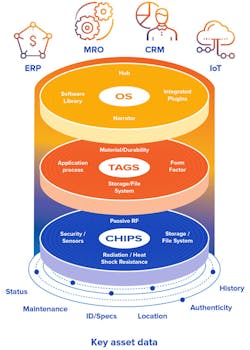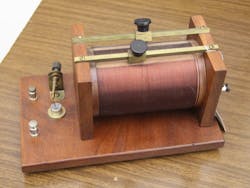7 Signs That Now Is the Time for Energy Harvesting
This file type includes high resolution graphics and schematics when applicable.
Energy harvesting collects energy that would otherwise go to waste, such as heat, vibrations, and sunlight, then converts it to electricity and puts it to use. It may not be a technology you are familiar with, but it is poised to become mainstream and change the way we power our electronic devices and what we think of as an energy source.
In many cases, energy harvesting can eliminate batteries from wireless devices.
In other cases, it lets batteries be augmented by other power sources, improving reliability and extending the operational life of the device. Several key concepts are coming together to make energy harvesting an even more popular choice for powering devices.
Let's look more closely at seven forces that are driving the technology today.
Transducers Are Getting More Advanced
Available energy sources are all around us, from both man-made and natural sources.
The goal of energy harvesting is to capture the currently unused energy and convert it to electricity. Transducers are the devices that turn one form of energy into another. A human’s sense organs, for example, are transducers that turn light, chemicals, pressure, and motions into nervous signals. Man-made transducers, also called sensors, do the same thing, but often convert the input (color, sound, chemical presence) into an electrical signal.
Steady advances in transducer technology, especially recent breakthroughs in materials and semiconductors, have made new types available and increased the efficiency of all of them. Micromechanical systems (MEMS)—moving parts built onto application-specific ICs (ASICs)—are a good example. They let complete transducers be built on a single chip, thus opening the door to major improvements in efficiency and cost. Other on-chip transducers are now available for temperature, chemical detection, and pressure. Surface acoustic wave (SAW) resonators are another good example. SAWs have been understood for over a century and the resonators have often been used in filters and oscillators. Today, new techniques are creating transducers useful for converting sources of mechanical and acoustic energy into electricity.
As transducer types and efficiencies expand, so do the methods and tools of energy harvesting.
C Chip for Energy Harvesting and the IIoT
Tego’s Asset Intelligence Platform uses energy harvesting for IIoT applications. Data connectivity is handled by rugged industrial products/assets or components beginning at the time of manufacturing so that the product can tell a story about its manufacturing processes, materials, and entire lifecycle of activities. Information stored on the product or asset itself streamlines processes and everyday activities for distributors and aftermarket service providers. Data on the asset transforms how all stakeholders see, act, and engage with the asset.
The platform has three layers, the foundational layer being the TegoChip which is a UHF RF chip that harvests energy from readers to read, write, and manage structured and unstructured data, files, and images stored on the asset or product. TegoChips are packaged inside TegoTags, which can be embedded into materials of finished goods, can survive rugged manufacturing processes including gamma sterilization, and tags can be optimized depending on how they are used and the amount of data stored on the asset. Products with the chip are “born” smart and they gather information and data, history, and condition changes throughout its lifecycle.
The information gathered, stored, and managed on the product is critical to asset lifecycle management, regulatory and safety compliance, and/or integrity management.
TegoOS is the communication layer of the AIP that lets qualified stakeholders with an iPhone, Android, or Windows operating system read, write, manage, and store data on any product or asset.
Low-Power Circuitry Uses Even Less Power
Just as the power available from transducers has been increasing, the power needed to run electronic circuits has been decreasing. That’s because at a given switching frequency, power requirements fall as a device’s geometries shrink. A good example of this is the RFID chip. Current versions have enough processing power to perform a digital handshake with the reader and respond to dozens of commands, yet they only need 10 microwatts to operate, meaning they can operate by converting the RF energy from the reader into electricity, so they do not need batteries.
Power improvements do not totally depend on semiconductor advances. Power consumption has become a major concern with larger chips such as microprocessors, graphics engines, and communications devices. But their appetite for electricity has motivated circuit designers to develop low-power designs for digital and analog circuits. The improvements made for large chips are being carried over to smaller circuits, resulting in devices that can be powered entirely from harvested energy.
The IoT Is Driving Devices Closer to the Edge
The Internet of Things (IoT) is here and expanding rapidly. Depending on which analyst you refer to, predictions of connected “things” range from 20 billion to 50 billion in three years. Our computers, smartphones, and web servers are already connected, so the next connectivity wave will focus on devices. Most of those devices will not be continuously powered, always on, and with their own IP address. Instead, they will mostly be small wireless devices that push the edge of the network farther and farther from the nearest data center.
We are rapidly approaching the point where the internet’s endpoints are data collections associated with a single item rather than powerful computers all talking to each other. These items might be automobile components moving through an assembly plant, packages of drugs or food traveling through a supply chain, or tens of thousands of tiny sensors scattered across a farm. Every case is an example of the move to highly distributed data and an understanding of the value these smart assets have in revealing operational data regarding quality, maintenance, and opportunities.
As connected devices get smaller and further out on the edge, powering them with batteries becomes more of a problem. There are industries such as aviation and energy where assets are expected to last for decades and the number of parts in service and inventory can number in the hundreds of millions. The prospect of replacing batteries, even as infrequently as every five to 10 years, is simply a non-starter. In other cases, the network edge is so “out there” that accessibility is a major hindrance. Consider sensors embedded within structural members or walls. Battery replacement is simply not an option in such locations.
IIoT “Smart Assets” on the Runway
Tego's Asset Intelligence Platform was designed and launched in the commercial aviation market to enable data “connectivity” for all stakeholders in the value chain. Initial customers include OEM part manufacturers for Airbus and Boeing.
It lets products/assets store lifecycle data for manufacturers, airlines, and MRO providers. Benefits include streamlining the workflow for airlines (28x improvement), 20% lifecycle extension for MROs, and 40M Euros in savings in configuring new planes.
There are more than 3,000 intelligent components on newer airplanes. That number is expected to grow to 10,000 per plane. And all the smart-airplane parts use energy harvesting technology instead of batteries because it is less expensive, less intrusive to use, and will easily last the 30-year lifecycle most airplane parts need to be operational.
Electronic Costs Are Coming Down Faster than Battery Costs
Much of the impetus behind the move toward smart connected assets is simply that it is now economical to do so. Electronic chips and their associated packaging enjoy economies of scale that let companies tag billions of assets with substantial computing power and memory, and do so at an attractive price. The price of the electronics is so low, if a battery is needed, it can represent a major fraction of the cost of the device cost. This is a major reason behind the move to devices relying on energy harvesting for power.
In some situations, the size of the connected module is a limiting factor. Similar to cost, the size of electronic modules has been on a steady decline, putting us in a situation where computing devices fit on the tip of a pin (yes, the sharp end). Battery technology has not kept pace, so modules that require batteries may not satisfy design requirements because modules would be too large.
One possibility for addressing the reliability, management, and size issues associated with batteries is to remove them all together. Energy harvesting is making this possibility a reality.
IoT Infrastructure Supports Devices on the Edge
Data networking has been on a relentless march toward faster connection speeds, but the rise of the IoT brings with it an interest in slower message services that can be run using far less power.
Wireless devices like laptops and cell phones are connected by protocols that are fast, cover large distances, and are power-hungry. A remote metering application, on the other hand, might only send and receive a few short messages per month. Each of those sensors scattered across a farm, for example, might only need to upload a few bytes of data per day. New transmission standards are being deployed to support these new applications.
Wireless Ethernet protocols like “Green Ethernet” are being designed with the data needs of small edge devices in mind, and consequently they have far smaller power requirements on individual endpoints. Bluetooth now comes in a Bluetooth-LE (low energy). The UHF RFID standard created by EPCglobal was designed specifically for tags without batteries. 2G and 3G cellular technologies support machine-to-machine applications, but do so using the same bandwidth and price points of cell phones. New low-power wide-area networking standards, including next-generation cellular, are replacing 2G and 3G with much lower transmission rates that are perfect for IoT applications.
All these new transmission protocols let edge devices communicate using astonishingly low amounts of power, which means batteries might not be needed at all.
Devices Are Only as Reliable as their Power Sources
As wireless devices are deployed in larger numbers, end users are discovering that battery reliability is not usually up to the task. A typical goal for the low-power networking protocols described above is often a 10-year battery life on a single coin cell. Several approaches are claiming success. These estimates often rely on simple calculations that compare steady-state power consumption to battery capacity specifications. Real-world deployments, however, often show unacceptable failure rates.
The problem is that battery lifetime is a multi-dimensional problem. Battery reliability begins with the manufacturing process. Unlike electronic components that have easy-to-predict lifetimes, batteries are based on chemical processes that have many different failure modes. Even manufacturers who weed out infant mortalities still have field failures, and the unavailability of data makes it impossible to include those failures in models and calculations.
Accurately predicting battery lifetime is critical when designing a module for volume deployment. If a high percentage of devices must last 10 years, the average device lifetime will probably need to be 15 or 20 years, but which is it? Initial battery conditions, temperature, shock, vibration, discharge rates, and usage patterns all need to be accounted for. In recharge applications, depth of discharge has an exponential effect on lifetime. All these factors contribute to the difficulty of accurately predicting battery life, and getting it wrong means too many failures and systems that don’t perform.
Removing the battery and replacing it with an energy harvester is a great way to improve reliability. It’s also possible to create hybrid modules that combine energy harvesting approaches with batteries or other storage devices like supercapacitors. Manufacturing failures will still need to be addressed, but battery lifetimes can be extended or made much more reliable by adding even a small charging rate from scavenged or harvested power. This is also a good way to address instances where harvested energy is too small or too intermittent to power a module. A temperature sensor in food packaging, for example, might be designed to use vibrational energy from transportation vehicles, but if the vibration transducer is too small, it will not produce enough energy for the task. In that case, energy could be collected over minutes or even hours. Once enough stored energy is available, the module turns on, takes a sensor reading and stores the result, and then powers back down.
As the need for reliable power at the edge continues to grow, advances in energy harvesting techniques provide a useful alternative or augmentation to batteries.
IoT Is Causing a Rethinking of System Architectures
Over the past several decades, the number of network infrastructures and networked computing devices has grown. Today’s ubiquitous connectivity influences thinking when it comes to deploying new systems and is based on assumptions that even the most remote devices can always be on, always connected, and always ready to respond. Imagine you are designing a warehouse application that quickly locates parts in inventory. The traditional internet solution to this problem puts a battery-powered transponder on each asset. When a particular part needs to be found, a request from a computer connected to the central system in the warehouse broadcasts a “where are you now?” message. The asset being addressed determines its location, perhaps through radio beacons in the building or perhaps GPS, and responds.
As IoT deployments become more common and edge devices are deployed in large numbers, the excessive cost to build and maintain such a system is becoming obvious. Today’s smart assets take a distributed approach to the problem, putting much of the system data directly on assets and often removing central servers in the process. An alternative architecture for the warehouse location problem is to tag each asset with a battery-free tag that can be scanned at key locations so that movement is always monitored. By rethinking the question as “where were you last?,” each asset no longer has to always be on. This is a new way of thinking about network capabilities and architectures, but these types of approaches open the door for extremely low-power alternatives powered by energy harvesting.
In summary, a confluence of several forces is transforming remote wireless devices in a world in which batteries provide less and less of the power. The number of edge devices is growing, as is the desire to push those devices further out on the edge, making batteries undesirable due to size, cost, and reliability. Simultaneously, advances in energy transducers and low-power circuits are making energy harvesting feasible in places where it would not have been an option a few years ago. With the IoT driving the demand and technology improvements creating the supply, we can expect the proliferation of energy harvesters to be right around the corner.
Bob Hamlin is chief technology officer of Tego Inc.
The Birth of Energy Harvesting
A crystal radio receiver needs no power sources; they use the power of incoming radio waves received by a wire antenna. They consist of a few inexpensive parts: a copper coil wire, capacitor, crystal detector, and earphones. Unlike radios that came later and required power sources, crystal radio receivers are passive receivers.
Although the crystal radio never regained the same popularity it enjoyed at its inception, the Boy Scouts have kept the construction of a radio set in their program since the 1920s. More recently, hobbyists have revived the act of designing and building examples of these early instruments. Today, annual contests let crystal radio aficionados compete and commune around a beloved and celebrated energy-harvesting technology.
This file type includes high resolution graphics and schematics when applicable.





